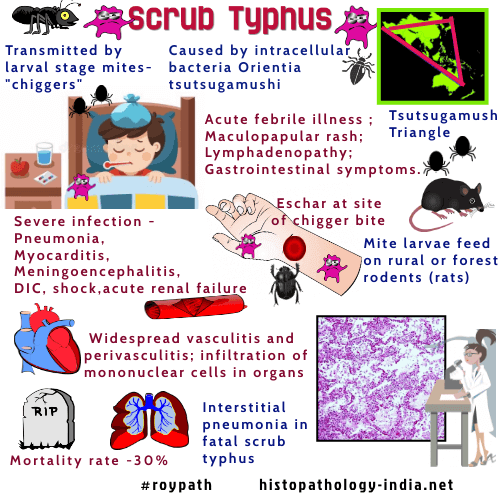|

Custom Search
|
|
Infectious Disease Online Pathology of Scrub Typhus
|

|
Syn: Tsutsugamushi disease ; Bush Typhus ; Mite-Borne Typhus; Tropical Typhus Scrub typhus is a mite-borne disease caused by bacteria called Orientia tsutsugamushi (formerly Rickettsia tsutsugamushi). Scrub typhus is related to rickettsial diseases. Orientia tsutsugamushi is an obligate intracellular bacteria. Scrub typhus is endemic in the South-east Asia, northern Australia and the western Pacific, in a geographical area known as the 'scrub typhus triangle' or 'tsutsugamushi triangle'. The mites inhabit rural areas such as scrub forests, tall grasslands and plantations. Infected mites pass the infection transovarially to their larvae (chiggers), which crawl to the tips of vegetation, scrub and bush plants. Mite larvae (chiggers), feed on forest and rural rodents, including rats, voles, and field mice. These larvae attach to a passer-by rather than to the usual host, the rat. While feeding, the mite passes the organism into the skin. A multiloculated vesicle forms at the inoculation site and ulcerates, after which an eschar (a dry scab or slough formed on the skin) forms. As the eschar heals, there is a sudden onset of headache, malaise, anorexia, weakness, and fever, followed by pneumonia, a macular rash (on the trunk before the limbs), lymphadenopathy, hepato-splenomegaly, and conjunctivitis. Mild infections may exhibit only fever. The most common gastrointestinal symptoms of scrub typhus patients included vomiting, nausea, diarrhea and hematemesis or melena. Gastrointestinal signs included hepatomegaly, jaundice and abdominal pain. Since multiple serotypes exist and cross-immunity is transient, recurrent infections are common. Severe infections are complicated by meningoencephalitis involving cranial nerves, focal myocarditis, pneumonia and circulatory collapse. Mortality rate range up to 30%. The rickettsiae grow in the endothelial cells and produce vasculitis. There are "typhus nodules", but these are usually smaller than those of epidemic typhus. Necrosis of the skin and lymph nodes and a dense mononuclear infiltrate in the heart and lungs are seen in severe cases.
|
|
|
Copyright © 2022 histopathology-india.net

